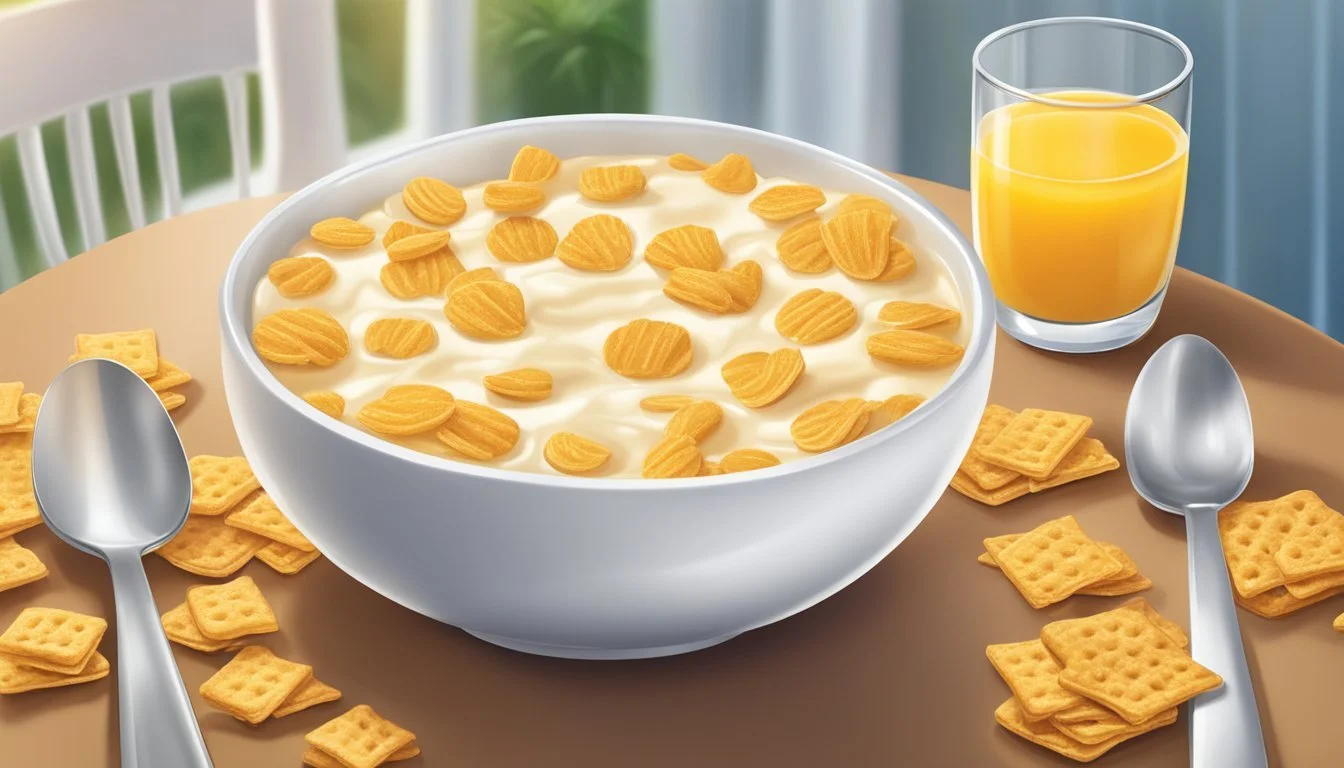Golden Grahams Nutrition Facts & More
Analyzing the Cereal's Health Profile
Golden Grahams, a popular breakfast cereal produced by General Mills, has been a staple in many households for decades. This crunchy, graham cracker-flavored cereal offers a sweet start to the day for both children and adults alike.
A single serving of Golden Grahams (1 cup or 40 grams) contains 150 calories, with 86% of those calories coming from carbohydrates, 9% from fat, and 5% from protein. The cereal provides some nutritional benefits, including iron, vitamin A, and vitamin B6. It's made with whole grain wheat, which contributes to its 2 grams of dietary fiber per serving.
While Golden Grahams does offer some nutritional value, it's important to note that it is relatively high in sugar. The cereal contains both sugar and brown sugar syrup among its main ingredients. Those watching their sugar intake may want to consider portion sizes or explore lower-sugar alternatives for their morning meal.
Nutritional Profile Overview
Golden Grahams cereal provides a mix of macronutrients and essential vitamins and minerals. The cereal's nutritional composition is primarily carbohydrates, with smaller amounts of protein and fat.
Macronutrients
A 1-cup (40g) serving of Golden Grahams contains 150 calories. Carbohydrates make up the majority of the calorie content at 86%, with 34g per serving. The cereal provides 2g of protein, accounting for 5% of the total calories. Fat content is relatively low at 1.5g, contributing 9% of the calorie total.
The carbohydrate content includes both complex carbohydrates from whole grain wheat and simple sugars. Sugar is listed as an ingredient, contributing to the overall carbohydrate profile.
Vitamins and Minerals
Golden Grahams is fortified with several essential vitamins and minerals. Iron stands out as a significant nutrient, with one serving providing 73% of the Daily Value (DV). The cereal also contains 50% DV of vitamin B6 and 21% DV of vitamin A.
Other added nutrients include calcium, zinc, vitamin C, and niacin. The exact percentages for these vary but contribute to the overall nutritional value of the cereal.
Sodium content should be noted, as cereals can be a source of added salt in the diet. The specific amount is not provided in the search results but is an important consideration for those monitoring sodium intake.
Dietary Considerations
Golden Grahams cereal offers a mix of nutrients but also presents some dietary challenges. Its composition impacts various dietary needs and health goals.
Allergens and Sensitivities
Golden Grahams contain wheat, which is a common allergen. Individuals with celiac disease or gluten sensitivity should avoid this cereal. The product may also be produced in facilities that process nuts, so those with nut allergies should exercise caution.
Some versions of Golden Grahams contain soy, another potential allergen. Consumers should carefully read labels, as formulations can vary between countries and product lines.
Dietary Fiber and Sugars
Golden Grahams provide some dietary fiber, but the amount is relatively low compared to whole grain cereals. A typical serving contains 1-2 grams of fiber.
The cereal is high in sugar content. A 3/4 cup serving (31g) contains about 9 grams of sugar, much of which is added sugar. This high sugar content contributes significantly to the cereal's calorie count and may affect blood glucose levels.
Balanced Diet Context
Golden Grahams are primarily a carbohydrate-based food. A 3/4 cup serving provides about 25 grams of carbohydrates, with only small amounts of protein (2g) and fat (1g).
While the cereal is fortified with vitamins and minerals, it should not be relied upon as a primary source of nutrients. Its high sugar and low fiber content make it less ideal for sustained energy or weight management goals.
Incorporating Golden Grahams into a balanced diet requires consideration of portion sizes and complementary foods to ensure adequate nutrient intake and manage sugar consumption.
Impact on Health
Golden Grahams cereal can affect various aspects of health due to its nutritional composition. The cereal's ingredients and nutrient profile influence heart health, blood sugar levels, and weight management.
Heart Health
Golden Grahams contains whole grain wheat, which provides some fiber. However, with only 2 grams of fiber per serving, it falls short of high-fiber cereals. The cereal's sodium content may be a concern for those monitoring blood pressure.
Saturated and trans fats are minimal in Golden Grahams, which is positive for heart health. The cereal is cholesterol-free, making it suitable for those on low-cholesterol diets.
Iron fortification in Golden Grahams supports cardiovascular function. One serving provides 73% of the daily iron requirement.
Blood Sugar Regulation
Golden Grahams has a high glycemic index of 72, indicating it can cause rapid blood sugar spikes. This makes it less ideal for individuals managing diabetes or insulin sensitivity.
The cereal's sugar content, including added sugars like brown sugar syrup and honey, contributes to its impact on blood glucose levels. Excessive sugar intake may increase the risk of developing type 2 diabetes over time.
The low protein content (5.3g per 100g) does little to slow down sugar absorption, potentially leading to energy crashes after consumption.
Weight Management
With 374 calories per 100 grams, Golden Grahams is relatively energy-dense. Its high carbohydrate content (85g per 100g) and low fiber may not promote feelings of fullness, potentially leading to overeating.
The cereal's added sugars contribute empty calories without significant nutritional benefits. Regular consumption of such foods can contribute to weight gain if not balanced with a healthy diet and exercise.
Despite its sweet taste, Golden Grahams' low fat content (7% of calories) may be beneficial for those watching their fat intake. However, the high sugar content offsets this advantage in terms of overall calorie management.
Detailed Nutritional Breakdown
Golden Grahams cereal provides a mix of macronutrients with a focus on carbohydrates. Its nutritional profile includes various fats, carbohydrates, and proteins, along with added vitamins and minerals.
Fats Composition
Golden Grahams contains a small amount of fat, typically around 1-2 grams per serving. The fat content comes primarily from the canola and/or sunflower oil used in the cereal's production. These oils contribute mostly unsaturated fats, which are considered healthier than saturated fats.
The cereal contains trace amounts of polyunsaturated and monounsaturated fats. These fats play a role in maintaining cell membranes and supporting various bodily functions. While Golden Grahams is not a significant source of omega-3 fatty acids like DHA or EPA, it does provide a small amount of essential fatty acids.
Carbohydrates Profile
Carbohydrates make up the majority of Golden Grahams' nutritional content, accounting for approximately 85-87% of its calorie content. A typical serving contains around 25-30 grams of carbohydrates.
The carbohydrates in Golden Grahams come from various sources:
Whole grain wheat and corn meal (complex carbohydrates)
Added sugars (simple carbohydrates)
Small amount of dietary fiber
The cereal contains several types of sugars, including sucrose, fructose, and glucose. These sugars contribute to its sweet taste and provide quick energy. The fiber content, while not high, adds some nutritional value and may aid in digestion.
Proteins and Amino Acids
Golden Grahams contains a modest amount of protein, typically 2-3 grams per serving. This accounts for about 5-6% of the cereal's calorie content. The protein comes mainly from the whole grain wheat used in the cereal.
While not a complete protein source, Golden Grahams provides small amounts of various amino acids, including:
Leucine
Isoleucine
Valine
Lysine
Threonine
These amino acids contribute to various bodily functions, including muscle maintenance and enzyme production. However, Golden Grahams should not be relied upon as a primary source of protein or essential amino acids in the diet.
Recommended Consumption
Golden Grahams, like many breakfast cereals, can be part of a balanced diet when consumed in moderation. Proper serving sizes and frequency of consumption are key factors to consider. Comparing Golden Grahams to other cereals can help in making informed dietary choices.
Serving Size and Frequency
The recommended serving size for Golden Grahams is 3/4 cup (30g). This serving contains 120 calories, which is about 6% of a 2,000-calorie daily diet. It's important to measure portions accurately, as overfilling the bowl can lead to excess calorie intake.
Adults should limit their consumption to 1-2 servings per week as part of a varied diet. Children may enjoy Golden Grahams as an occasional treat, but it shouldn't replace more nutritious breakfast options on a regular basis.
The cereal provides 10% of the Daily Value for several vitamins and minerals per serving. These include iron, vitamin A, and vitamin B6. However, it's low in fiber, offering only 2 grams per serving.
Comparison to Other Cereals
Golden Grahams has a higher sugar content compared to many whole-grain cereals. It contains 9 grams of sugar per serving, which is 18% of the recommended daily limit for added sugars.
Nutritionally, it falls short of cereals fortified with more fiber and protein. Whole-grain options often provide 3-5 grams of fiber per serving, compared to Golden Grahams' 2 grams.
Here's a quick comparison:
Nutrient Golden Grahams Average Whole-Grain Cereal Fiber 2g 3-5g Sugar 9g 5-7g Protein 2g 3-4g
Consumers looking for a healthier alternative might consider cereals with less added sugar and more fiber and protein. These options can provide more satiety and long-lasting energy throughout the morning.
Label Reading and Interpretation
Nutrition labels provide crucial information about Golden Grahams' nutritional content. Consumers can use these labels to make informed decisions about incorporating the cereal into their diet.
Understanding the Nutrition Label
The Nutrition Facts panel on Golden Grahams boxes displays key nutrient information. Serving size is typically 3/4 cup or 31 grams. This amount contains 120 calories, with 1 gram of fat, 25 grams of carbohydrates, and 2 grams of protein.
The label lists percentages of Daily Values (%DV) for various nutrients. Golden Grahams provides 10% DV for calcium and 25% DV for iron per serving. Added sugars are also indicated, allowing consumers to track their intake.
Ingredients are listed in descending order by weight. Whole grain wheat and corn meal are the primary ingredients in Golden Grahams, followed by various forms of sugar.
Identifying Marketing Claims
Golden Grahams packaging may feature marketing claims that require careful interpretation. "Whole grain" is a common claim, as the cereal contains whole grain wheat as its first ingredient.
Claims about vitamins and minerals are often highlighted. Golden Grahams is fortified with several B vitamins and iron. However, it's important to note that these added nutrients do not necessarily make the cereal a health food.
"No artificial flavors" is another frequent claim. While true, this doesn't mean the cereal is free from added sugars or other processed ingredients. Consumers should compare these claims with the full ingredient list for a complete picture.








